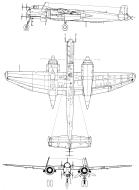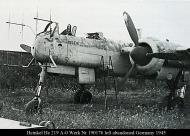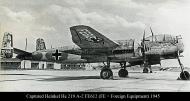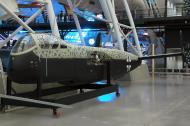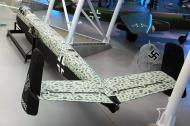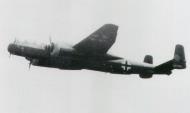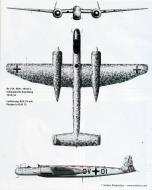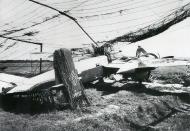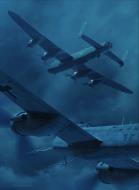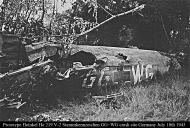Heinkel He 219 Owl photograph data
Heinkel He-219A NJG
Photo 01: It has been noted that three camouflage schemes were applied to the He-219. Having established that the overall black finish applied when the Nachtjagd was first created was unsuitable as a night camouflage, and having developed alternative and more effective schemes, it seems strange that in the last months of the war the use of black was revived for use on the undersurfaces and the outer surfaces of the twin fins and rudders of some He-219s. A possible explanation may be that the RAF's offensive caused such giant conflagrations in German cities that the light from the fires may have illuminated the night fighters' 76 undersurfaces to an unacceptable degree. As seen on this machine, however, where black was applied, uppersurfaces were usually finished in 75 and 76.
Heinkel He-219A NJG WNr 290112 Hildesheim
Photo 01: This He-219 A-2 found at Hildesheim, almost certainly WNr. 290112, shows again the black finish on the undersurfaces. It would be tempting to associate the application of the black with the night strafing of Allied motor transport and other targets of opportunity, a task assigned to the Nachtjagd during the battle for Normandy in the summer of 1944 and which continued through to the battle of the Ardennes. Neither this, however, nor the suggestion put forward (Heinkel He-219A NJG 01), explains why such a finish appeared only on the He-219 and, later, the very few two-seat Me 262 night fighters to see operational service. In any event, the black scheme on these aircraft was a permanent, factory-applied finish, and it seems improbable that the industry would apply a scheme for use on aircraft where night ground-attack was only a temporary role.
Heinkel He 219A2 WNr 290013 Germany May 1944
Photograph Source: Flugzeug Classic 2008-09
Prototype Heinkel He 219 V-2 Stammkennzeichen GG+WG crash site Germany July 10th 1943
Photograph Source: Flugzeug Classic 2008-10
Heinkel He 219 A-0 Werk Nr 190176 left abandoned Germany 1945
Photograph Source: Flugzeug Classic 2008-10
Heinkel He 219 A-0 1./NJG1 Kommandeur Paul Foster Venlo Holland summer 1944
Photograph Source: Flugzeug Classic 2008-10
Captured Heinkel He 219 A-2 FE-612 (FE = Foreign Equipment) 1945
Photograph Source: Flugzeug Classic 2008-10
Heinkel He 219 Owl
The Heinkel He 219 Uhu ("Eagle-Owl") was a night fighter serving with the German Luftwaffe in the later stages of World War II. A relatively sophisticated aircraft, the He 219 possessed a variety of innovations, including an advanced intercept radar. It was also the first operational military aircraft in the world to be equipped with ejection seats, and the first German aircraft with tricycle landing gear. Had the Uhu been available in quantity, it might have had a significant effect upon the strategic bomber offensive of the Royal Air Force, but only 268 were built before the end of the War and they saw only limited service.
Design and development
Due to political rivalries between Josef Kammhuber, commander of the German night fighter forces, Ernst Heinkel, the constructor, and Erhard Milch, responsible for aircraft construction in the Reichsluftfahrtministerium (RLM — the German Aviation Ministry), the development and production of the aircraft was tortuous. The aircraft was also complicated and expensive to construct, a factor that further limited the number of aircraft produced.
When Robert Lusser returned to Heinkel from Messerschmitt, he began work on a new high-speed bomber project called P.1055. This was an advanced design with a pressurized cockpit, twin ejection seats (the first to be planned for use in any combat aircraft), tricycle landing gear featuring a nosegear that rotated its main strut through 90º during retraction, to fit flat within the forward fuselage, and remotely-controlled defensive gun turrets similar to those used by the Messerschmitt Me 210. Power was to be provided by two DB 610 "coupled" engines producing (2,200 kW/2,950 hp) each, delivering excellent performance with a top speed of approximately 750 km/h (470 mph) and a 4,000 km (2,500 mi) range with a 2,000 kg (4,410 lb) bomb load.
The RLM rejected the design in August 1940 as too complex and risky. Lusser quickly offered four versions of the fighter with various wingspans and engines in order to balance the performance and risk. At the same time, he offered the P.1056 dedicated night fighter with four 20 mm cannons in the wings and fuselage. The RLM rejected all of these on the same grounds in 1941. Heinkel was furious and fired Lusser on the spot.
About the same time as Lusser was designing the P.1055, Kammhuber had started looking for a dedicated aircraft for his rapidly-growing night fighter force. Heinkel quickly re-designed P.1055 for this role as the P.1060. This design was similar in layout but somewhat smaller and powered by the smaller and simpler liquid-cooled DB 603 inverted V12 engine, using annular radiators similar to the ones on the Jumo 211-powered Junkers Ju 88A, but considerably more streamlined in appearance. This engine was not known for its altitude performance, which was a problem for this design with its short wings, but Daimler offered a new "G" version that addressed that issue. Heinkel was sure he had a winner and sent the design off to the RLM in January 1942 while he funded the first prototype himself. Nevertheless, the RLM again rejected the He 219 in favour of new Ju 88- and Me 210-based designs.
Construction of the prototype started in February but suffered a serious setback in March, when Daimler said that the DB 603G would not be ready in time. Instead, they would deliver a 603A with a new gear ratio to the props, with the new designation 603C. Even these took until August to arrive, and the prototype did not fly until 6 November 1942.[2] When Kammhuber saw the prototype on the 19th, he was so impressed he immediately ordered it into production over Milch's objections. Milch — who had rejected the He 219 in January — was enraged.
Stability problems were noted, but Heinkel overcame the problem by offering a cash prize to engineers who could fix the problem. Further changes were made to the armament; the dorsal rear defensive guns - mounted atop the fuselage, and firing from a fixed, internal-mount rear facing dorsal "step" position at a point just aft of the wings' trailing edge - were removed due to their ineffectiveness. The forward-firing armament was increased to two 20 mm cannons in the wing roots and four more guns or cannons mounted in the ventral tray.The A-0 model also featured a bulletproof shield that could be raised in the front interior cockpit, hiding the entire bottom portion of windscreen, providing temporary pilot protection, leaving a slot by which the gunsight could be aimed at a bomber and fired. Production prototypes were then ordered as the He 219 A-0 (production prototype aircraft) and quickly progressed to the point where V7, V8 and V9 were handed over to operational units in June 1943 for testing.
Operational history
Photo: Bundesarchiv Bild 146-1972-004-32, Heinkel He 219 als Nachtjäger.jpg
The He 219 had an auspicious combat debut. On the night of 11–12 June 1943, Werner Streib flew the V9 and shot down five bombers between 01:05 and 02:22 hours, before crashing on landing.[4] A claim consistently made is that, "In the next 10 days the three Heinkel He 219A-0 pre-production aircraft would shoot down a total of 20 RAF aircraft, including six of the previously "untouchable" de Havilland Mosquito fighter-bombers. Greatly encouraged, Kammhuber continued to press for immediate production." No record of corresponding Mosquito losses or any documentary evidence exists, however, to suggest that He 219 pilots actually made claims for six Mosquitos during this time.
Production finally got underway with the He 219 A-2 model which included a longer engine nacelle containing an extra fuel tank and typically included the Rüstsatz R1 kit with two 30 mm (1.18 in) MK 108 cannons installed as an offensive Schräge Musik upward-firing system, installed completely within the fuselage. Production problems due to Allied bombing in March[10] meant the A-2/R1 did not reach Luftwaffe units until October 1943. The first 10-15 aircraft were delivered with the 490 MHz UHF-band FuG 212 Lichtenstein C-1 radar sets, complete with their 32-dipole element Matratze antenna array.
Milch repeatedly tried to have the program killed and in the process, Kammhuber was removed from office. Production ceased for a time but was restarted because the new Junkers Ju 388s were taking too long to get into service. Only 206 He 219s had been produced in the previous 15 months. Soon the A-5 began production and was the first major production variant He 219 to enter production. The A-5 featured an updated, 90 MHz VHF-band Telefunken FuG 220 Lichtenstein SN-2 radar system, complete with their larger, draggy Hirschgeweih aerials. It had less range than the C-1, but improved accuracy and resolution and was less vulnerable to chaff jamming.
The He 219 was a capable fighter aircraft, allowing the pilots a large degree of autonomy. Ground control simply got them into the right area and then the pilots took over and hunted down the bombers on their own; the SN-2 radar's 4 km (3 mi) range was greater than the distance between the bombers. While the performance of the A-5 was not extraordinary — approximately 580 km/h (360 mph) speed — it was enough of an advance over the Messerschmitt Bf 110s and Junkers Ju 88Gs to allow the aircraft to chase several bombers in one sortie.
In order to combat the Mosquito, the He 219 had all excess weight removed. With some weapon and radio systems deleted the aircraft was able to attain a speed of 650 km/h (400 mph). This version was given the designation A-6.
The last major production version was the A-7 with improved DB603E engines. The A-7 could be outfitted with two 30 mm (1.18 in) MK 108s in the wing roots, two 30 mm (1.18 in) MK 103 cannons and two 20 mm MG 151/20 cannons in a ventral tray and two 30 mm (1.18 in) MK 108s in a Schräge Musik installation mid-way down the fuselage, fully contained within it. The relatively long-barreled MK 103s, however were not usually fitted due to weight considerations.
The follow-on series was to be the He 219B fitted with the new, but very troublesome, 1,864 kW (2,500 hp) Junkers Jumo 222A/B 24-cylinder engines, which would have allowed the He 219 to reach 700 km/h (440 mph). They were also to have had increased wing spans of 22.06 m (72.38 ft) for better high-altitude performance. The Jumo 222s did not reach production status however, and only a test machine or two were ever fitted for the engines; some additional airframes with the enlarged wing were slated to fly with high-altitude versions of the DB 603. But again, only one or two test machines ever flew in that configuration.
A further adaptation would have been the He 219C, also intended to use the big wing and Jumo 222 powerplants as well as an all-new fuselage of 17.15 m (56.27 ft) and a complete three-man Ju 388J cockpit section forward and a manned power tail turret aft. Day bomber and night fighter versions were proposed and metal was cut on the project, but without the Jumo engines, they never flew.
Paper projects include the very-high-altitude He 219E with a vastly increased wingspan of 28.5 m (93.5 ft) and DB 614 engines, which were apparently an uprated DB 603G capable of 1,491 kW (2,000 hp).
A more reasonable project was the Hütter Hü 211, a design created by Wolfgang Hütter, that took a standard He 219 fuselage and tail and added a long-span, high aspect ratio wing of 24.55 m (80.54 ft) to create a fast, high-altitude interceptor. Since this design was to be powered by the Jumo 222, it was fated to never fly, although work continued on two sets of wings until they were destroyed by Allied bombing.
The He 219 was the only piston-engined night fighter capable of facing the British Mosquito on equal terms, given its speed, manoeuvrability and fire power, but it never played a significant role in the war because the industry failed to make it available in sufficient numbers
Variants
He 219 A-0
initially used for pre-production aircraft but became first major production version with 104 built, 1,750 PS DB 603A engines
He 219 A-1
Proposed reconnaissance-bomber aircraft. The project was abandoned.
He 219 A-2
similar to A-0 but extended engine nacelles with additional fuel tanks, 1,670 PS DB 603AA engines, 85 built
He 219 A-2/R1
Two-seat night fighter version, armed with two 30 mm (1.18 in) MK 108 cannons in a ventral tray, two 20 mm MG 151/20 cannons in the wing roots, plus 30 mm (1.18 in) two MK 108s just behind the cockpit.
He 219 A-5
planned three-seat night fighter, only some prototypes built from A-2 airframes known
He 219 A-6
planned Mosquito-hunter, stripped-down version of the He 219 A-2, armed with four 20 mm MG 151/20s
He 219 A-7
Improved night-fighter version, powered by two 1,800 PS DB 603E engines, 210 ordered as of 31 November 1944
He 319
An unbuilt multi-role aircraft project entirely unrelated to the He 219, only having the number sequence in common.
He 419
Various derived projects culminating in He 419B-1/R1, six of which were flown; use of the He 319 tail, very long-span wing of 59 square metres (635 sq ft), two 20 mm MG 151/20 in the wings and four 30 mm MK 108 in ventral housing. Speed of 422 mph (679 km/h to 44,619 ft (13600 m)) .
Survivors
Starting on 16 June 1945, the U.S. Army Air Force Intelligence Service as part of "Operation Lusty" (Luftwaffe Secret TechnologY) took control of three He 219s at Grove in Jutland, Denmark, base of the 1st Night Fighter Wing (Nachtjagdgeschwader 1) when the war ended. These aircraft were made flight-worthy by "Watson's Whizzers" and flown to Cherbourg, France. He 219 A-2 Werknummer 290202, was shipped to the United States with 21 other captured German aircraft on board the British aircraft carrier HMS Reaper and were reassembled at Ford Field, Newark, New Jersey. Werknummer 290202 was given the foreign equipment number FE-614 and later T2-614. It was flown to Freeman Field, Indiana for flight testing along with a second of the three He 219s; a He 219 A-5 prototype, Werknummer 290060 and given the foreign equipment number FE-612. The fate of Werknummer 290060 is unknown. Following testing the He 219 A-2 Werknummer 290202 was then moved in 1946 to Orchard Place Airport in Park Ridge, Illinois. It was stored in a vacant aircraft factory and then transferred to the Smithsonian's National Air Museum on 3 January 1949. Finally the He 219 was crated and shipped to the Smithsonian's Silver Hill, Maryland storage facility in early 1955. He 219 A-2 Werknummer 290202 is undergoing restoration in the collection of the Smithsonian National Air and Space Museum in Washington D.C., USA. Recently the fuselage has been put on display at the Steven F. Udvar-Hazy Center by Dulles Airport, however the wings are still being restored at the Paul Garber Facility in Suitland, Maryland. Today the fuselage can be seen displayed near the museum's Dornier Do 335 and Arado Ar 234, aircraft that accompanied it across the Atlantic over 60 years ago.
Drawing: 0-He-219A-7-3-way-drawing-of-Heinkel-He-219A-7-R1-0A
Specifications (He 219 A-7) 3-way drawing of Heinkel He 219A-7/R1
Data from Jane's Fighting Aircraft of World War II
General characteristics
* Crew: 2
* Length: 15.5 m (51 ft 0 in)
* Wingspan: 18.5 m (60 ft 8 in)
* Height: 4.4 m (14 ft 5 in)
* Wing area: 44.4 m² (478 ft²)
* Max takeoff weight: 13,580 kg (29,900 lb)
* Powerplant: 2× Daimler-Benz DB 603E liquid-cooled inverted V12 engine, 1,800 PS (1,324 kW) each
* Propellers: VDM three blade constant speed airscrew
Performance
* Maximum speed: 616 km/h (333 kn, 385 mph)
* Range: 1,540 km (831 nmi, 960 mi)
* Ferry range: 2,148 km (1,160 nmi, 1,335 mi)
* Service ceiling: 9,300 m (30,500 ft)
Armament
* Guns:
o up to 4 × 20 mm MG 151 cannons in a detachable fairing under the fuselage, 300 rpg
o 2 × 20 mm MG 151s in wing roots, 300 rpg
o 2 × 30 mm (1.18 in) MK 108 cannons, Schräge Musik (oriented 65° above horizontal), 100 rpg
Specification (A-7/R1)
Type: two-seat night fighter;
Powerplant: 2 x 1,900hp Daimler-Benz DB 603G 12-cyclinder inverted-vee engines;
Performance: 416mph / 670kph (maximum speed), 391mph / 630kph (cruising speed), 40,025 ft / 12,200m (service ceiling), 1,243 miles / 2,000 km (maximum range),
Weight: 24,692lbs / 11,200kg (empty), 33,730lbs / 15,300kg (maximum take-off);
Dimensions: 60ft 8.25in / 18.5m (wing span), 50ft 11.75in / 15.54m (length), 13ft 5.5in / 4.10m (height), 479.01sq.ft / 44.5m.sq (wing area);
Armament: 4 x 30mm MK108 cannon, 2 x 20mm MG151/20 cannon & 2 x 30mm MK103 cannon;
Used: Germany.
History
The Heinkel He219 Uhu (Owl) was potentially one of the Luftwaffe's best and most effective night-fighters but suffered from the misjudgements of senior members of the government and the Luftwaffe (most notably Generalfeldmarschall Erhard Milch, Inspector General of the Luftwaffe, who took over from Ernst Udet when the latter committed suicide in November 1941) as did many other programmes, such as the Me262. Despite the aircraft being fast, manoeuvrable and having devastating firepower, proving itself the equal of Allied fighter-bombers such as the de Havilland Mosquito, Milch succeeded in having the programme abandoned in favour of the Junkers Ju388J and the Focke-Wulf Ta154. However, a number of aircraft were produced even after the secession of formal interest and production totalled around 288 aircraft, including prototypes. The Reichsluftfahrtministerium (RLM) had been lukewarm about the project from the very beginning. It stemmed from a private venture by Ernst Heinkel AG, designated the P.1060 fighter-bomber and was proposed as a multi-purpose aircraft. The programme languished however until 1941, when night raids by the RAF were becoming such a problem that the RLM asked for it to be redesigned as a night-fighter. The all-metal shoulder-wing cantilever monoplane with a tailplane having considerable dihedral and ending in twin rudders and fins incorporated a number of novel features. The pilot and navigator who were seated back-to-back enjoyed excellent visibility from a cockpit that was placed at the very front end of the fuselage at the nose, well forward of the guns so that their flashes did not affect their eyesight. The crew were also equipped with ejector seats, the He219 being the world's first operational aircraft to carry such equipment and it was also the first aircraft that had tricycle landing gear (with a steerable nosewheel) to achieve operational status with the Luftwaffe.
The first prototype was flown on 15 November 1942, powered by two 1,750hp Daimler-Benz DB 603A engines, with armament trials following at Peenemünde in December. The aircraft was originally armed with two 20mm MG151 cannons in a ventral tray and a moveable 13mm (0.51in) MG131 machinegun in the rear cockpit. In February 1943, the aircraft was fitted with four 30mm MK108 cannon in place of the MG151s, but this showed a tendency to part company with the fuselage when all four were fired. The second prototype meanwhile, flown in December 1942, carried four MG151 cannon in a ventral tray and two similar weapons, one in each wing root. On 8 January 1943, the He219 V2 was flown in competition with the Ju188 but the test proved somewhat inconclusive so they were followed on 25 March 1943 by more extensive trials. The aircraft, flown by Major Werner Strieb, competed against a Junkers Ju188S flown by Oberst Viktor von Lossberg and a Dornier 217, which retired early. The He219 V2 acquitted itself well in the trials, so much so that the 'off the drawing board' order for 100 was increased to 300. Additional prototypes were constructed to run in the development programme, including a fourth which was equipped with the FuG220 Lichtenstein SN-2 radar, while production got underway at Rostock, Vienna-Schwechat as well as Mielec and Buczin (both of which were in Poland). From April 1943, a small number of He219A-0 preproduction aircraft were flying with 1 / NJG1 at Venlo in Holland and on the night of 11/12 June 1943, Major Streib shot down five Avro Lancasters in a single sortie. The first six operation sorties resulted in claims of some twenty British aircraft being downed, including six Mosquitoes. In December 1943, Milch suggested that the entire He219 programme be discontinued in favour of the Ju88G. Milch's main objection was that the He219 would be disrupting production lines at a critical time and that the performance of the Junkers was sufficient to take on bombers such as the Lancaster and Halifax. The major flaw in this argument was that the British had begun to use Mosquitoes to escort their night bombers and the Junkers was incapable of combating this superb British fighter-bomber. He initially put forward three proposals that firstly, that Heinkel should abandon the He219 altogether in favour of the Junkers Ju88G and Dornier Do335; secondly that He219 production was reduced in favour of the Ju88G; and thirdly production of the He219 should go ahead as planned. Despite the third option being followed for a time, Milch eventually got his way and the programme was cancelled in May 1944, despite the aircraft being universally popular with air and ground crews alike. A number of variants were produced however and deliveries were made to several units, principally 1 / NJG1 and NJGr10. The He219A-1 reconnaissance bomber was abandoned early in the development stages, so the first variant to roll off the production line was the He219A-2/R1 night-fighter, equipped with two MK108 cannons in the ventral tray and two MG151/20 cannon in the wing roots, while a Schräge Musik installation with two MK108 cannon installed behind the cockpit firing obliquely up and forwards was fitted retrospectively.
The first major production version however, was the He219A-5 series, with the A-5/R1 being similar to the A-2/R1 except for the fitting of an eighty-six Imp gal (390-litre) fuel tank at the rear of each nacelle adding some 400 miles (645km) to the range. A variety of other sub-variants were produced however, including the He219A-5/R2 with 1,800hp DB 603Aa engines and the He219A-5/R4 that had a third crew member and a stepped cockpit with a 13mm (0.51in) MG131 machinegun in a trainable mount. The need to find a counter to the RAF's Mosquito's led to the development of the He219A-6 series, which was introduced in early 1944. This was basically a stripped down version of the He219A-2/R1 equipped with 1,750hp DB 603L engines and armed with four 20mm MG151/20 cannons, a similar aircraft but one that was armed with only two MG151/20 cannon was built under the designation He219B-2. The final production version consisted of the A-7 series, which introduced larger supercharger intakes for the DB 603G engines but were otherwise similar to the A-5 series and all carried the then-standard Schräge Musik installation. The A-7/R1 had, in addition, two MK108 cannon in the wing roots, along with two MG151/20 and Mk103 cannon in the ventral tray, while the A-7/R2 had two MK108 cannon instead of the MK103s in the ventral tray and the A-7/R3 had MG151/20 cannon in the wing roots rather than MK108s. The A-7/R4 carried tail warning radar but only four MG151/20 cannon. The six He219A-7/R5 aircraft were powered by 1,900hp Junkers Jumo 213E engines but were otherwise identical to the He219A-7/R3. A single He219A-7/R6 was produced, equipped with 2,500hp Junkers Jumo 222A/B engines, as was a single three-crew He219B-1 which was to use the same powerplant but instead used DB 603Aa engines. Finally, a He319 version was proposed as a night fighter being basically the same as the He219 but with a single fin and rudder. The design was abandoned in November 1942 in favour of the He419. The He419A-0 was basically the He219A-5 fitted with a new, enlarged wing and DB 603G engines. This aircraft was followed by six He419B-1/R1 aircraft, which had exhaust-driven turbochargers and an increased wing area of some 635sq.ft (59m.sq). The standard armament was four MK108 and two MG151/20 cannons while the B-1/R2 was projected as having four MG212 weapons and the B-1/R3 having four MK103 cannons.
More Research
Book References: +
- Gunston, Bill. The Illustrated Encyclopedia of Combat Aircraft of World War II, Salamander Books, London, 1978.
- Kay, A L & Smith, J R. German Aircraft of the Second World War, Putnam Aeronautical Books, London, 2002.
- Mondey, David. The Hamlyn Concise Guide to Axis Aircraft of World War II, Bounty Books, London, 2006.
- Boyne, Walter J. Clash of Wings. New York: Simon & Schuster, 1994. ISBN 0-684-83915-6.
- Bridgeman, Leonard (editor). “Heinkel He 219.” Jane’s Fighting Aircraft of World War II. London: Studio, 1946. ISBN 1-85170-493-0.
- Chorley, W.R. Royal Air Force Bomber Command Losses of the Second World War, Volume 5 1944 - amendments and additions, Volume 6 1945 - amendments and additions. London: Ian Allen Publishing, 1997. ISBN 978-0904597912.
- Chorley, W.R. Royal Air Force Bomber Command Losses of the Second World War, Volume 6 1945 - amendments and additions. London: Ian Allen Publishing, 2004. ISBN 978-0904597929.
- Franks, Norman L.R. Royal Air Force Fighter Command Losses of the Second World War: Volume 3. Operational Losses: Aircraft and Crews 1944-1945 (Incorporating Air Defence Great Britain and 2nd TAF): 1944-1945. Hersham, Surrey, UK: Midland Publishing, 2000. ISBN 978-1857800937.
- Green, William. Warplanes of the Third Reich. London: Macdonald and Jane's Publishers Ltd., 1970 (fourth Impression 1979). ISBN 0-356-02382-6.
- Green, William and Gordon Swanborough. "Heinkel's Nocturnal Predator... The He 219". Air Enthusiast. Issue Forty, September–December 1989. Bromley, Kent:Tri-Service Press. pp. 8–19, 70–72.
- Greenhous, Brereton. The Crucible of War: 1939-1945. Toronto: University of Toronto Press, 1994. ISBN 0-80200-574-8.
- Kay, Anthony and John Richard Smith. German Aircraft of the Second World War: Including Helicopters and Missiles (Putnam's History of Aircraft). London: Putnam, 2002. ISBN 0-85177-920-4.
- Nowarra, Heinz J. Heinkel He 219 "Uhu". Atglen, PA: Schiffer Publishing Inc., 1989. ISBN 0-8874-0188-0.
- Remp, Roland. Heinkel He 219: An Illustrated History Of Germany's Premier Nightfighter. Atglen, PA: Schiffer Publishing Inc., 2007. ISBN 0-7643-1229-4.
- Smith, J.R. and Antony L. Kay. German Aircraft of the Second World War. London: Putnam, 1972. ISBN 1-85177-836-4.
Magazines: +
- Airfix Magazines (English) - http://www.airfix.com/
- Avions (French) - http://www.aerostories.org/~aerobiblio/rubrique10.html
- EDUARD - https://www.eduard.com/
- EDUARD - Are in my opinion are what modelers are looking for loads of pictures and diagrams and have become a leading historical information source. *****
- FlyPast (English) - http://www.flypast.com/
- Flugzeug Publikations GmbH (German) - http://vdmedien.com/flugzeug-publikations-gmbh-hersteller_verlag-vdm-heinz-nickel-33.html
- Flugzeug Classic (German) - http://www.flugzeugclassic.de/
- Klassiker (German) - http://shop.flugrevue.de/abo/klassiker-der-luftfahrt
- Luftwaffe IM Focus (German) - https://www.luftfahrtverlag-start.de/
- Embleme der Luftwaffe Band-1 (German) - https://www.luftfahrtverlag-start.de/
- Le Fana de L'Aviation (French) - http://boutique.editions-lariviere.fr/site/abonnement-le-fana-de-l-aviation-626-4-6.html
- Le Fana de L'Aviation (French) - http://www.pdfmagazines.org/tags/Le+Fana+De+L+Aviation/
- Osprey (English) - http://www.ospreypublishing.com/
- model airplane international magazine - https://adhpublishing.com/shop/store/magazine-backissues/model-airplane-international-backissues/
- Revi Magazines (Czech) - http://www.revi.cz/
Web References: +
- eBay - https://picclick.de/ or https://www.ebay.com
- Pinterest - https://www.pinterest.com
- Wikipedia.org - http://en.wikipedia.org/wiki/Heinkel_He_219
 Editor for Asisbiz: Matthew Laird Acred
Editor for Asisbiz: Matthew Laird Acred
If you love our website please subscribe to our YouTube video channel
Please donate so we can make this site even better !!

